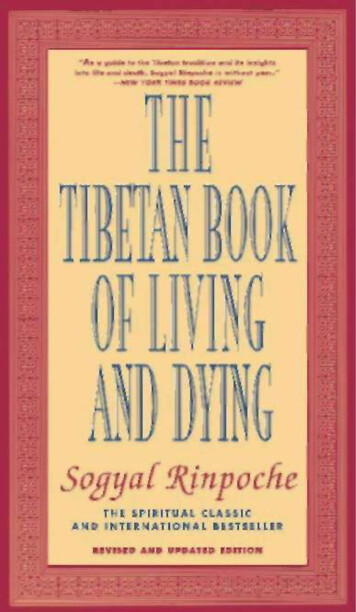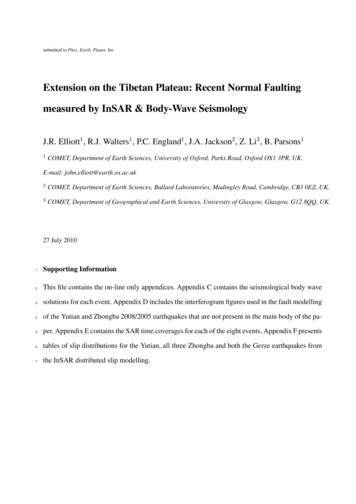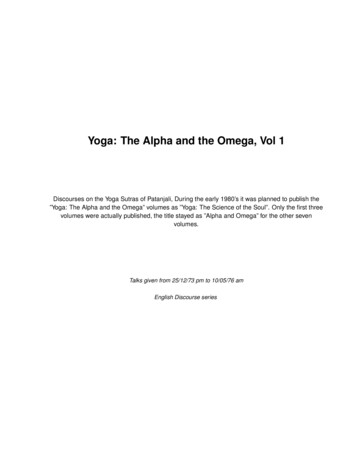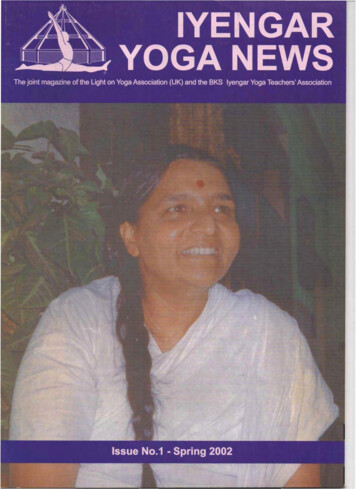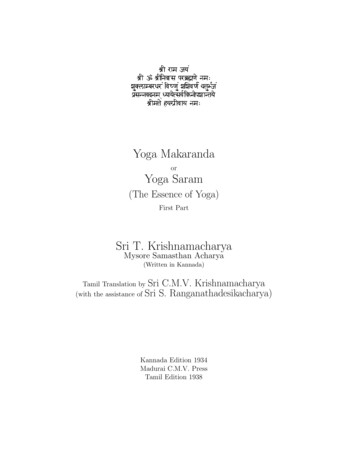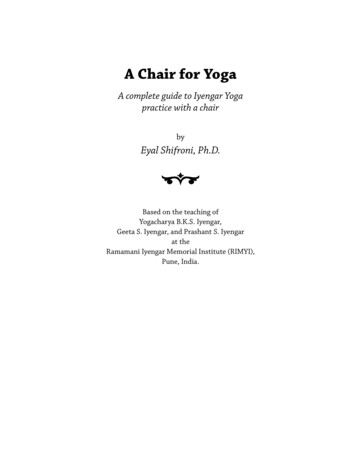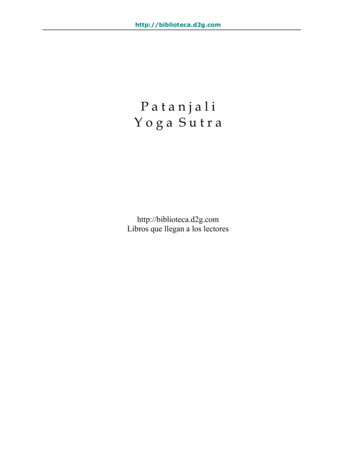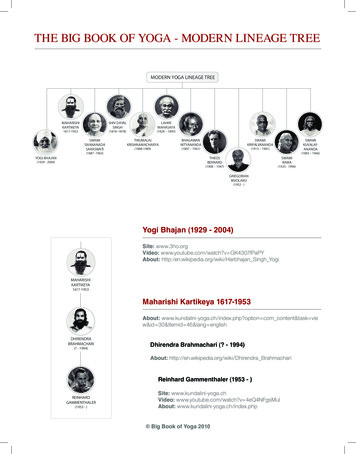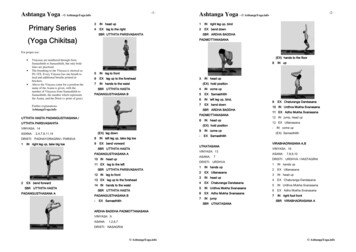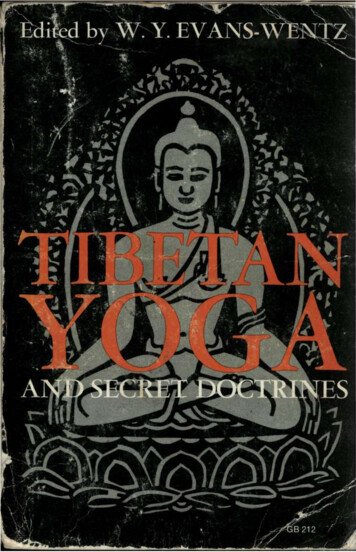
Transcription
RELIGIONTIBETAN YOGAAND SECRET DOCTRINESSeven authentic Tibetan yoga texts, almost unknown to the occidentalworld until their first publication in English in 1935, are now availablein this Galaxy Book edition. A companion to the unique Tibetan Bookof the Dead (GB 39), which the late Dr. Evans-Wentz also edited, thisvolume, illustrated with photographs and reproductions of yoga paintingsand manuscripts, contains some of the principal meditations used byillustrious Hindu and Tibetan gurus and philosophers through the agesin attaining Right Knowledge and Enlightenment. The editor, whoseinquiry and research extended through more .than fifteen years in theOrient, spent much time as a pupil of Hindu sages and Buddhist lamas.He has included a body of orally transmitted tradition and teachingsreceived at first hand. These will be of particular interest to anthropologists and psychologists, and to students of comparative religion andpractically applied Mahayana Yoga. Special commentaries precede eachcarefully rendered text, and a comprehensive preface contrasts the tenetsof Buddhism with European concepts of religion, philosophy, and science.Yoga, the tap root of Hinduism, Jainism, Zen Buddhism, and Taoism,has also influenced the development of Judaism, Islam and Christianity.These seven distinct but intimately related books, arranged in orderlysequence, afford a comprehensive view of the spiritual teachings whichhave shaped the culture of the Orient, and which are now increasinglyenriching the West's appreciation of the depths of the human psyche.The late W. Y. Evans-Wentz, formerly of Jesus College, Oxford, isalso the editor of The Tibetan Book of the Dead (GB 39), The TibetanBook of the Great Liberation (GB 260), and Tibet's Great Yogi,Milarepa (GB 294). His substantial tetralogy of works on yoga, basedon translations from the Tibetan, offers an "interpretation from within"rarely found in the works of Western scholars. During the early yearsof this century Dr. Evans-Wentz lived in India and in Sikkim, at theinvitation at the Maharaja Sidkyong Tulku, where he studied occultdoctrines intensively.A GALAXY BOOKOXFORD UNIVERSITY PRESS, NEW YORKISBN 0-19-500278-4Cover design by Rita Kaye SchwartzSecond EditionSeven Books of Wisdom of the Great PathArranged and edited by W. Y. Evans-Wentz
(2)(1)(3)(4)(5)(6)From Photographs by the EditorMODERNGURUSDescribed on pages xviii-xix
TIBETAN YOGAANDSECRET DOCTRINESOR SEVEN BOOKS OF WISDOM OF THEGREAT PATH, ACCORDING TO THELATE LAMA KAZI DAWA-SAMDUP'SENGLISH RENDERINGArranged and Editedwith Introductions and Annotationsto serve as a Commentary byW. Y. E V A N S - W E N T ZM.A.,D.LITT.,D.Sc.Jesus College, Oxford; Author ofThe Fairy-Faith in Celtic Countries;The Tibetan Book of the Dead;Tibet's Great Yogi Milarepa; TheTibetan Book of the Great Liberation, &c.W i t h ForewordbyD R . R. R. M A R E T TandYogic CommentarybyTRANSLATOR-PROFESSORSECONDCHEN-CHI CHANGEDITIONOXFORD UNIVERSITY PRESSLONDONOXFORDN E W YORK
OXFORD UNIVERSITY PRESSOxford London GlasgowNew York Toronto Melbourne WellingtonIbadan Nairobi Dares Salaam Cape TownKuala Lumpur Singapore Jakarta Hong Kong TokyoDelhi Bombay Calcutta Madras Karachi W. Y. Evans-Wentz, 1958First published by Oxford University Press, London, 1935Second Edition, 1958First published as an Oxford University Press paperback, 1967This reprint 1978Printed in the United States of America
THIS BOOKOFSEVEN BOOKS OF WISDOMOF THE YOGA PATH DIRECTI DEDICATETO THEM THAT SHALL SUCCEED MEIN THE QUEST ON EARTH
WISDOM-TEACHINGS AND GOOD-WISHES OF THEADI-BUDDHA SAMANTA-BHADRA' T h e Foundation of all is uncreated, uncompounded, independent,beyond mental concept and verbal definition. Neither the term Sangsaranor the term Nirvana can be applied to It. To realize It is to attainBuddhahood. Not to realize It is to wander in the Sangsara. . . .'Not knowing the Foundation, beings aforetime erred. They wereoverwhelmed by the darkness of unconsciousness, whence sprang ignorance and error. Immersed in error and obscured by ignorance, the" k n o w e r " became bewildered and afraid. Then arose the concepts" I " and " O t h e r s ' ' , together with hatred. When these had grownstrong, there was born an unbroken current of sangsaric evolution. Thenthe ''five poisons" of the obscuring passions, lust, anger, selfishness,delusion, and jealousy, flourished, and there was produced an interminable chain of evil karma.'The root-source of error among sentient beings is thus unconsciousignorance. And, in virtue of the power of the Good-Wishes of Me, theAdi-Buddha, may each of them realize the radiant, immaculate mind,innate in every living thing.'From The Good-Wishes of the All-Good Buddha Samanta-Bhadia(Lama Kazi Dawa-Samdup's Translation).
PREFACETOTHEFIRSTEDITIONAS in The Tibetan Book of the Dead and in Tibet's GreatYogi Milarepa so in this book, the third in a threefoldseries, my aim has been to place on record not only a catenaof carefully made translations of texts which are as yet almostunknown in Occidental countries, but also a body of orallytransmitted traditions and teachings relating to the texts,which I received from the late Lama Kazi Dawa-Samdup,who was my Tibetan guru.The present work thus contains much that is new toWestern thought, and much that, apart from its value forphilosophy and religion, is interesting anthropologically. Itshould prove to be of the same quality and public appeal asthe two volumes of the series which have already been published. Perhaps it may be found to be the most valuablemember of the trilogy, inasmuch as it gives the very texts ofsome of the principal yogas and meditations which many ofthe most illustrious Tibetan and Indian philosophers, includingTilopa, Naropa, Marpa, and Milarepa, employed in attainingRight Knowledge.This volume is meant at once for the exact scholar and forthe general reader. The former will note that the originaltextual sources, which are sevenfold, are authentic, and thatnothing has been incorporated into the texts or presentedin the introductions and annotations which has not doctrinalsanction.The seven chief texts upon which the seven Books, or parts,comprising this volume are based contain teachings and matterdating a long way beyond the time to which the actual manuscripts and block-prints can be referred. A full discussion ofthis question is contained in the special introductions to theseven Books. The shortened titles of these seven texts, rendered into English, are as follows:(1) Gampopa's Supreme Path, called ' T h e Precious Rosary',consisting of twenty-eight categories of yogic preceptsfor the guidance of the disciple;
viiiP R E F A C E TO T H E F I R S T E D I T I O N(2) The Epitome of the Great Symbol, a treatise on thepractical yogic method of realizing Nirvana;(3) The Epitome of the Six Doctrines, which are thePsychic-Heat, the Illusory Body, the Dream-State, theClear Light, the After-Death State, and the Transference of the Consciousness;(4) The Transference of the Consciousness, a yogic treatisecomplementary to the last of the Six Doctrines;(5) The Method of Eradicating the Lower Self a treatiseon the Yoga of Non-Ego;(6) The Five-Fold Wisdom Attribute of the Long Hum,a treatise on the Yoga of the Five Wisdoms;(7) The Essence of the Transcendental Wisdom, a shortSutra belonging to the Prajna-Paramita of the Tibetancanon.For the benefit of the general reader, I have prefixed to thetreatise, in the form of a General Introduction, a brief accountof Buddhism, so presented as to contrast with our Europeanconceptions of religion and philosophy, and, to some extent,science. Similarly, in my exposition of the Yoga Philosophy,upon which the treatise as a whole is based, I have made useof teachings which have come to me from trustworthy teachersduring the course of careful inquiry and research extendingover a period of more than fifteen years, spent mostly in theOrient.In a realm so filled with difficulties for the Europeanmind as this book attempts to explore, it is not to be expectedthat I have always escaped error. In any event, I trust thatreaders and critics of this volume will recognize in it, despiteany such shortcomings as it may perhaps exhibit, a sincereeffort to help, in some small degree, to bring about amongst thepeoples of the Western World a better understanding of someof the master minds of Tibet and of India.Once more in the preface of a printed book, and probablyfor the last time in this incarnation, I here acknowledge myindebtedness to the late Lama Kazi Dawa-Samdup, withoutwhose patient toil and guidance neither this treatise nor thetwo treatises which have prepared the way for it would ever
P R E F A C E TO T H E F I R S T E D I T I O Nixhave been written. I also acknowledge my indebtedness toeach of my other preceptors and helpers in India and Tibetand throughout the Occident.In this connexion I cannot omit to record the name ofDr. R. R. Marett, Reader in Social Anthropology in theUniversity of Oxford, and Rector of Exeter College, who hasnever failed to offer encouragement and sound advice to me,his old pupil, during the past twenty-seven years, that is tosay, ever since I came up to Oxford. And now I am furtherindebted to him for the Foreword to this volume.I am also very grateful to my good friend and helper,Mr. E. T. Sturdy, translator of The Narada Sutra, forhaving read over, both when it was in typewritten form andwhen it was in proof, the matter contained within these covers,and more particularly for having given attention to the Sanskrit terms and to my exposition of Vedantic doctrines.With respect to certain problems relating to the originalTibetan texts, I have been fortunate in having been able toquestion Dr. F. W. Thomas, Boden Professor of Sanskrit inthe University of Oxford.I owe another debt of like nature to Dr. F. A. M. Spencer,lately Chaplain of Brasenose College, Oxford, and author ofa number of works, including Civilization Remade by Christ,and The Theory of Christ's Ethics, who read the typewrittencopy of this volume before it went to the printers, and contributed some constructive criticism concerning certain Christianproblems herein touched upon.To Sir E. Denison Ross, Director of the School of OrientalStudies, University of London, grateful acknowledgement ishere made for permission to use his copy of the late LamaKazi Dawa-Samdup's rendering of the Lodan-Gawai-Roltso.And I am also indebted to the Bhikkhu ParaweheraVajiranana, attached to the Vidyodaya College, Colombo,Ceylon, at present in England and a candidate for the Degreeof Doctor of Philosophy in the University of Cambridge, forhaving critically examined my exposition of yogic practices inrelation to Southern Buddhism.Nor must I forget to thank the many friends who have
xPREFACE TO T H E FIRST EDITIONvoluntarily written to me from the four quarters of the Earthto express appreciation, to offer helpful criticism with respectto my two preceding books, and to convey encouragement forthe publication of the present book. Special thanks are due toMadame M. La Fuente, Secretary of Les A mis du Bouddhisme,of Paris, for her faithful translation of The Tibetan Book of theDead into French, published as Livre des Morts Tibetain(Paris, 1933).In such manner, then, has this concluding volume of theseries been made worthy of presentation to all classes ofreaders - to those more learned and to those less learned. It isoffered to the world as a direct gift from Sages who have advanced far upon the Great Path, known as the Mahayana. Theirfervent hope, transmitted through their initiated disciple, thetranslator, and, in turn, through him to the editor, was thatthe teachings contained within this treatise might meet withsympathetic and careful consideration on the part of the moreadvanced thinkers of Europe and of the two Americas. Theyfelt, too, that the time had come for a freer exchange of thoughtbetween those who devote themselves to investigating anddeveloping the psychic powers innate in man and those whoare more concerned with studying the visible phenomena ofthe external universe. It is only when the West understandsthe East and the East the West that a culture worthy of thename of civilization will be evolved. In thus coming to realizethat it is in reality One Family, humanity will free itself of allsuch mentally obscuring concepts as are in this epoch concomitant with nationality, race, caste, or creed, and there willdawn a truly New Age.W. Y. E.-W.J E S U S COLLEGE, O X F O R D ,Midsummer Day,1934.
TABLE OF CONTENTSPREFACE TO T H E F I R S T EDITIONviiDESCRIPTION OF I L L U S T R A T I O N SxviiiF O R E W O R D : From the Celtic Faith in Fairies to the TibetanScience of Yoga, by Dr. R. R. MarettxxiiP R E F A C E TO T H E SECOND EDITION. xxvYOGIC COMMENTARY, by Translator-Professor Chen-ChiChangxxviiGENERALINTRODUCTIONI. The Importance and Original Sources of this VolumeII. The CommentaryIII. Some Misconceptions Concerning Buddhism . .IV. The Incompleteness of the Occident's KnowledgeBuddhismV. The Joyous Optimism of BuddhismVI. The Wisdom of the MahayanaVII. The Yoga PhilosophyVIII. Yoga and ReligionIX. Buddhistic YogaX . The Psychology o f the Yogic Visualizations. .XI. Karma and RebirthXII. The Exoteric Versus the Esoteric Teachings . .XIII. The Translating and Editing o f the Texts. .XIV. The Unity and Practical Value of the TextsXV. The New Renaissance and the Masters of Wisdom.1I33.of910142135. 3 8.4446.49.5153.54BOOK ITHE SUPREME PATH OF DISCIPLESHIP: T H EPRECEPTS OF T H E GURUST H E INTRODUCTIONI. The Book's Compiler and his Fellow Disciple .II. The Transmission of the TeachingsIII. The Texts of The Precious RosaryIV. The Precepts Compared with Elegant Sayings'.- 5 7575859.60.T H E OBEISANCE AND F O R E W O R D67T H E T W E N T Y - E I G H T CATEGORIES OF YOGIC P R E CEPTSI. The Ten Causes of RegretII, The Ten RequirementsIII. The Ten Things to be DoneIV. The Ten Things to be Avoided6767686970
xiiTABLE OF CONTENTSV . The Ten Things Not t o b e Avoided. . . .70VI. The Ten Things one Must Know. 71VII. The Ten Things to be Practised71VIII. The Ten Things to be Persevered in .73IX. The Ten Incentives73X. The Ten Errors74X I . The Ten Resemblances Wherein One May Err.75XII. The Ten Things Wherein One Erreth Not.76XIII. The Thirteen Grievous Failures76XIV. The Fifteen Weaknesses78XV. The Twelve Indispensable Things. . . .79XVI. The Ten Signs o f a Superior Man. . . .80XVII. The Ten Useless Things81XVIII. The Ten Self-imposed Troubles82XIX. The Ten Things Wherein One Doeth Good to Oneself 84XX. The Ten Best Things85XXI. The Ten Grievous Mistakes86XXII. The Ten Necessary Things87X X I I I . The Ten Unnecessary Things88XXIV. The Ten More Precious Things90XXV. The Ten Equal Things91XXVI. The Ten Virtues o f the Holy Dharma. . .92XXVII. The Ten Figurative Expressions. 9 6XXVIII. The Ten Great Joyful Realizations. . . .98T H E CONCLUSIONT H E COLOPHON99.100BOOK IIT H E NIRVANIC P A T H : T H E YOGA OFT H E GREAT SYMBOLT H E INTRODUCTIONI. The History of the Great Symbol Teachings.II. The Text and the TranslationIII. The Character of the Great Symbol Teachings .IV. TheLineoftheGurusT H E OBEISANCE AND F O R E W O R D .PART I: THE PRELIMINARY INSTRUCTIONS:T E M P O R A L AND S P I R I T U A L TEACHINGSP A R T I I : T H E E S S E N T I A L S U B J E C T MATTERThe Ordinary Practices1, The Yoga of One-Pointedness2. The Yoga of the Uncreated101101103. 108110.115THE.115121121122135
TABLE OF CONTENTSxiiiThe Extra-Ordinary Practices1. The Yoga of Transmuting Phenomena and Mind intoAt-One-Ment2. TheYogaofNonMeditationP A R T I I I : T H E CONCLUSIONRecognizing the Great Symbol; and the Four Yogic AttainmentsAnalysing the Impediments and Errors while Treading thePathDifferentiating Experiences and Practical from TheoreticalKnowledgeT H E COLOPHON145145148150150151153153BOOK IIITHE PATH OF KNOWLEDGE: THE YOGA OFTHE SIX DOCTRINEST H E INTRODUCTION155I. The Four Classes of Tantras155II. The Doctrine of the Psychic-Heat156III. The Doctrine of the Illusory Body161IV. The Doctrine of the Dream-State164V. The Doctrine of the Clear Light166VI. The Doctrine of the After-Death State.167VII. The Doctrine of the Consciousness-Transference. 169T H E OBEISANCE AND F O R E W O R D171C H A P T E R I: T H E DOCTRINE OF T H E PSYCHIC-HEAT 172Part I: The Five Preliminary Exercises1731. Visualizing the Physical Body as being Vacuous . 1732. Visualizing the Psychic Nerve-System as being Vacuous 1763. Visualizing the Protective Circle1774. Training the Psychic Nerve-Paths1805. Conferring the Gift-Waves' upon the Psychic NerveCentres181Part1.2.3.I I : The Three Fundamental PracticesProducing Psychic-HeatPsychic-Heat ExperiencesTranscendental Psychic-HeatPart I I I : The Practical Application1 . Obtaining the Benefit o f the Warmth2. Obtaining the Benefit of the Bliss.184184195200202202204
xivTABLE OF CONTENTSC H A P T E R I I : T H E DOCTRINE O F T H E ILLUSORYBODYPart I: Realizing the Impure Illusory Body to be Maya.Part I I : Realizing the Pure Illusory Body to be Maya .1. The Maya of the Visualizing State2. The Maya of the Perfected StatePart I I I : Realizing All Things t o b e Maya. . . .209209210210212214C H A P T E R I I I : T H E DOCTRINE O F T H E DREAMSTATEPart I: Comprehending the Nature of the Dream-State.1. Comprehending It by the Power of Resolution.2. Comprehending It by the Power of Breath.3. Comprehending It by the Power of Visualization .Part I I : Transmuting the Dream-Content. . . .Part I I I : Realizing the Dream-State to be Maya .Part I V : Meditating upon the Thatness of the Dream-State .215215216216217220221222CHAPTER I V : T H E DOCTRINE OF T H E CLEAR LIGHTPart I : The Fundamental Clear Light. . . . .Part I I : The Clear Light on the Path1. Blending the Nature of the Clear Light with the PathDuring the Day-Time2. Blending the Nature of the Clear Light with the PathDuring the Night-Time3. Blending the Nature of the Clear Light with the PathDuring the After-Death StatePart I I I : The Resultant Clear LightC H A P T E R V : T H E DOCTRINE O F T H E AFTER-DEATHSTATEPart I: Realizing the State of the Clear Light of the DharmaKaya while in the Bardo1 . The Bardo o f the Moments o f Death. . . .2. The Yogic Art of DyingPart I I : Realizing the State of the Sambhoga-Kaya while inthe Bardo1. Karmic Results of Inability to Recognize the Clear Light2. Description of the After-Death Existence.3. The After-Deat.h Attaining of Enlightenment.Part I I I : Realizing the State of the Nirmana-Kaya while inthe Bardo1. The Bardo of Seeking Rebirth2 . The Yogic Art o f Choosing a Womb. . . 42245
TABLE OF CONTENTSxvC H A P T E R V I : T H E DOCTRINE O F CONSCIOUSNESSTRANSFERENCEPart I: The Three TransferencesPart I I : The Transference of the Consciousness by Meditating upon the Guru1. The Practising2. The Practical ApplicationT H E COLOPHON246246247248250250BOOK IVTHE PATH OF TRANSFERENCE: T H E YOGAOF CONSCIOUSNESS-TRANSFERENCET H E INTRODUCTIONI. Pho-wa and its MasteryII. The Related Doctrine of TrongjugIII. The Yogic Tale Told by the GurusIV. The Yogic Tale Concerning TyphooV. The Secret Lore and its Survival253253254255256256P A R T I : T H E PROFOUND PATH O F CONSCIOUSNESSTRANSFERENCEThe RefugeThe Visualizing of Vajra- Yogin! and the Gurus . . .The Prayer to the GurusThe Prayer to theRoot-GuruThe Meditation upon the GuruThe Visualizing of Vajra-Dakini and the Gurus .The ColophonPART I I : T H E T R A N S F E R E N C E O F T H E CONSCIOUSNESS OF ONE DECEASEDThe Visualization for Devotees of Lower Degree.The Application of the Transference by Devotees of HigherDegreeThe State of the Highest DevoteesThe ColophonPART I I I : T H E DESCRIPTION O F T H E LINE O F T H OOK VTHE PATH OF THE MYSTIC SACRIFICE: THEYOGA OF SUBDUING T H E LOWER SELFT H E INTRODUCTIONI . The History o f the Doctrine o f Non-Ego .277277
xviTABLE OF CONTENTSII. The Tibetan Versification278III. The Practitioners of the Chad Rite280IV. The Essential Teachings281V. The Chod Rite as a Mystic Drama282VI. The Comparison with the Tibetan Mystery- Play . 284VII. The Origin of Disease According to the Lamas. 285VIII. The Comparison with the Bali Ceremony of Ceylon. 287IX. The Art of Exorcism287X . The Performance o f the Mystery-Play. . . . 289XI. The Kinchenjunga War-Dance294XII. The Anthropological Interpretation295XIII. The Bodhisaltva's Mystic Sacrifice297T H E YOGIC DANCE W H I C H DESTROYETH E R R O NEOUS B E L I E F S301T H E YOGIC DANCE OF T H E FIVE DIRECTIONS . 303T H E TRANSFIXING OF T H E ELEMENTALS OF S E L F . 306T H E VISUALIZING OF T H E GURUS AND DEITIES. 307T H E YOGINS PRAYER, AND RESOLUTION .308-9T H E DEDICATION OF T H E ILLUSORY BODY INSACRIFICE309T H E P R A Y E R TO T H E GURU310T H E VISUALIZING O F T H E CORPSE AND W R A T H F U L GODDESS311T H E SUMMONS TO T H E SACRIFICIAL FEAST. 312T H E OFFERING OF T H E SACRIFICIAL FEAST INWORSHIP314T H E O F F E R I N G O F T H E SACRIFICIAL F E A S T T OS P I R I T U A L BEINGS315T H E DEDICATING OF T H E ACT OF SACRIFICE . 315T H E DEDICATING O F T H E M E R I T O F T H E ACT O FSACRIFICE316T H E COLOPHON318T H E ADDENDUM319I. The Objects Needed for Practising the Rite. 319II. The Place and the Mental Imagery Prescribed. 321III. Directions to the Yogin323IV. The Visualizing of the Mandala324V. The Mixed, the Red, and the Black Feast. 325VI. The Meditation to Accompany the Sacrificial Offering . 327VII. The Time for Performing the Various Feasts . 328VIII. The Visualizing of the Human Skeleton and WrathfulDakini. 329
TABLE OF CONTENTSIX.X.XI.XII.The State of Mind NecessaryThe Final MeditationThe Good-Wishes and BenedictionThe Conclusionxvii.331332333333BOOK VITHE PATH OF T H E FIVE WISDOMS: THEYOGA OF THE LONG HUMTHEINTRODUCTION: T H E YOGA OF T H E FIVEWISDOMS .335T H E SYMBOLIC SIGNIFICANCE OF T H E LONG HUM . 339T H E OBEISANCE AND MEDITATION.340T H E CONCLUDING MANTRA341BOOK VIITHE PATH OF T H E TRANSCENDENTALWISDOM: THE YOGA OF T H E VOIDNESST H E INTRODUCTIONI. The Prajna-Paramita: its History and Esotericism .II. Translations from a n Apocr3'phal Text. . .III. The Canonical Texts and Commentaries. . .IV. The Doctrine of the Voidness Viewed Historically .V . The Absolute a s Inherent i n Phenomena . . .VI. The Practising o f the Prajna-Paramita. . .T H E OBEISANCET H E S A N S K R I T AND TIBETAN T I T L E.T H E QUESTION OF S H A R I - P U T R AT H E R E P L Y BY AVALOKITESHVARA.THE MANTRA OF THEPRAJNA-PARAMITA.T H E BUDDHA'S APPROVALT H E ADDENDUMI . The Superiority o f the Prajna-Paramita. . .II. The Three Kinds ofPrajnaIII. The Personal EgoIV. The Existence or Non-Existence of Atoms.INDEX343343346347349351352355. 355355.356. 358358359.359361362. 363.365
DESCRIPTION OF ILLUSTRATIONSI.MODERN GURUSFrontispiece(i) The late Lama Kazi Dawa-Samdup, as he appeared in the year1919, when he was the Head Master of the State School, nearGangtok, Sikkim. In the following year he was appointed Lecturerin Tibetan to the University of Calcutta. (2) The late Srimat Kuladananda Brahmachary, of the Jatiababaji Math, Puri. He was one ofthe most beloved gurus of the Madhwacharya Order, and had manydisciples, one of whom is kneeling at his side in reverent obeisance.He was physically remarkable for his beautiful features and luxuriantgrowth of hair, as the photograph suggests. To him the editor isindebted for a clearer understanding of some of the deeper problemsof yoga. (3) The late Jagat Guru Shankaracharya Madhusudan TirthaSwami, Head of the Shankaracharya Math (or Monastery), Puri,founded by the illustrious Shankaracharya himself. He is seated onthe seat of abbotship in his Math. Underneath him is the skin ofa royal Bengal tiger. At his right hand stands a brass kamandalu (orwater-pot) such as is commonly used by mendicants who have madethe Great Renunciation; and, at his left, a bamboo staff, symbolicalof the Brahma-danda (Staff of Brahma), represented by the spinalcolumn in man, and, also, indicative of his membership in the DandaOrder of Brahmin ascetics. He was revered for his remarkablepowers of intellect combined with spiritual insight; and to him, too, theeditor gratefully acknowledges indebtedness for guidance. (4) Thelate Vaidyaratna Pandit Maguni Brahma Misra, Teacher of Ayurveda,Government Sanskrit College, Puri. It was on New Year's Day,1921, that the Viceroy and Governor-General of India, then LordChelmsford, conferred upon him the title of Vaidyaratna ( G e m ofMedical Science'), in recognition of his eminent attainments. Theeditor, who knew him intimately and often enjoyed his hospitalityand scholarly assistance, can testify to the saintliness of his character.He was an ideal type of the guru who marries and lives as a householder and works in the world as a karma yogin. He was of ancientBrahmin lineage; and was blessed with four sons, all of whom survivehim. (5) Swami Syamananda Brahmachary, of Benares, author ofa treatise in English entitled Truth Revealed. The editor, whensojourning in the Holy City of the Hindus, in 1918, received fromhim much help. Swami Syamananda harmoniously combines powerof spirituality with power of intellect, and is representative of thekarma yogin who, although living in the world, has not followed thepath of the householder. (6) Srimat Sri Jukteswar Giri, Head of the
DESCRIPTION OF ILLUSTRATIONSxixKedar Ashrama, Puri. This venerable guru sits yogically postured,on a low wooden seat covered with a leopard skin, outside hisAshrama.II.T H E RAINBOW-EN HALOED S H R I N E , SYMBOLICALOF T H E CELESTIAL H I E R A R C H I E S. facing p. 1This Shrine stands in the centre of the library of the PemioncheMonastery, Sikkim. At the base of the rainbow, on the left, is to beseen the protruding end of a large dorje (or lamaic sceptre). On theshelf in front of the Shrine there are seven brass bowls filled withwater, which is an offering to the protecting deities; at either endthere is a flower-vase, and, next to that on the left, a vessel containingwater from which the water in the seven bowls is replenished. Inthe background, barely discernible, appear the Sacred Books, somein manuscript, some in block-print form, each carefully wrapped ina cloth and resting in separate pigeon-holes. The Monastery is builtat the end of a high, isolated mountain-spur, overlooking the eternalsnows of the Himalayan Ranges, in the Sacred Land of the Gods.III.T H E GLORIFIED BUDDHA AND T H E GURUGAMPOPAfacing p. 57Photographic reproductions (about three-quarters of the originalsize) of two water-colours, painted by the late Lama Kazi DawaSamdup.The Enlightened One is shown sitting in the Buddha-Posture,enthroned on a lunar disk upheld by the stamens and pericarp of alotus, enhaloed by a rainbow. His right hand is posed in the Earthtouching', or Witness-attitude' (Skt. Bhushparsha), in symbol ofHis having called the Earth to witness His Final Triumph over Evil(personified as the Tempter Mara) when He sat under the Bo-Treeat Buddha-Gaya about to attain Enlightenment. In his left hand Heholds the begging-bowl of the ascetic, symbolical of His worldrenunciation.The Guru Gampopa, otherwise known as Dvagpo-Lharje, Milarepa'smost spiritually developed disciple, is the compiler of The PreciousRosary, contained in Book I. He is shown in the garb of a Lama ofthe Kargyutpa Order, seated, in the Buddha-Posture, on a richlyembroidered meditation-cushion, in a preaching-booth. He holds aSacred Book, written in Tibetan, whence he is expounding theDoctrine of the Enlightened One - the Ending of Sorrow and the Wayof Final Deliverance.IV. T H E T W O C H I E F YOGIC P O S T U R E Sfacing p. 101The upper photograph shows Swami Satyananda (see p. 108) sittingin the Buddha-Posture (Skt. Padmasana), and the lower photograph
xxDESCRIPTION OF ILLUSTRATIONSshows him sitting in the Siddha-Posture (Skt. Siddhasana), atBirbhaddar, on the Ganges, near Rikhikesh. The Swami (cleanshaven of head and body) sits on a rug superimposed on the skin ofan Indian antelope (see p. 1864). In the distant background is to beseen the grass hut wherein the editor dwelt for a time when atBirbhaddar enjoying the Swami's assistance in the study of thingsyogic.V. T H E DIVINE DAKINI, VAJRA-YOGINI . facing p. 155A photographic reproduction (original size) of a painting in colours,on heavy cotton cloth, made on the instructions of the editor, inGangtok, Sikkim, by the Tibetan artist Lharipa-Pempa-Tendup-La.The description of Vajra-Yogini as given in our text, on pp. 173 to 175,is in general agreement with this Illustration. In the original painting,the Goddess, in keeping with her symbolic and esoteric character, isof a bright ruby-red colour.VI. FOLIOS 1 b ,2 a ,2 b ,3 a OF T H E PHO-WA MS. facing p. 253A photographic reproduction (slightly less than one-half of theoriginal size). The manuscript (written in the headed-letter scriptcalled in Tibetan Uchen) was acquired from the Tibetan yogin whosupplied the editor with the two manuscripts of Book V when theeditor met him in Darjeeling. (See p. 280.) It is probably not morethan fifty years old, having been copied from an old manuscriptbelonging to the yogin's guru. The small squares, noticeable on threeof the folios, represent bits of Tibetan paper (like that of all of ourTibetan manuscripts and block-prints) painted red, and pasted thereon,by the yogin when he was practising Pho-wa, in order to emphasizethe passages so marked.VII. FOLIOS 3 a , 3 b , 4 a , 4 b , 5 a OF T H E CHOD MS. facing p. 377A photographic reproduction (about one-half of the original size).This manuscript (written in the headless-letter script called in TibetanUmed), like the manuscript described above, is a modern copy ofan old manuscript. A practitioner of the Chod Rite
AND SECRET DOCTRINES Second Edition Seven Books of Wisdom of the Great Path Arranged and edited by W. Y. Evans-Wentz Seven authentic Tibetan yoga texts, almost unknown to the occidental world until their first publication in English in 1935, are now available in this Ga
